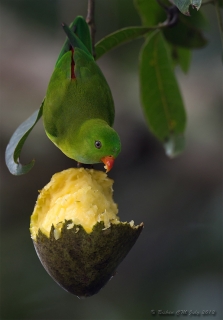Green Hanging Parrot |
|
|
Also known as: Small Sulawesi Hanging Parrot, Red-billed Hanging Parrot, Lilliput Hanging Parrot, Tulabula Hanging Parrot, Pygmy Hanging Parrot
Photos
View in GalleryDid You Know?
Hanging parrots hang upside down when roosting.Academic Research
Related publications: Loriculus exilisSpecies Profile
Genus: Loriculus | Species: exilis
Size:
11cm (4.3 in)
Weight:
Not recorded.
Subspecies including nominate:
one
Colour Adult:
Male-in general green in colour; red spot encircled by blue/green on throat; red rump and upper tail coverts, basally washed with yellow; green tail tipped with green/yellow. Bill red. Eye yellow. Female-as in male but red spot on throat minimal or missing. Eye brown.
Colour Juvenile:
Red on throat missing. Bill yellow/brown. Eye pale brown.
Call:
Single note calls; sad and plaintive. Contact calls are not heard from great distances.
Listen NowMore Information:
Content Sources:
CITES
BirdLife International
Cornell Lab of Ornithology/Birds of the World
A Guide to Parrots of the World, Juniper and Parr, 1998
xeno-canto Pygmy Hanging Parrot, Nelson, Mike XC151858
Parrots of the World, Forshaw and Cooper, 1989.
Parrots of the World, Forshaw, 2006.
Lexicon of Parrots, Thomas Arndt.
Parrots in Aviculture, Low, 1992.
Photos
View in GalleryDid You Know?
Hanging parrots hang upside down when roosting.Academic Research
Related publications: Loriculus exilisSpecies Care
Captive Status:
Rare
Longevity:
Not recorded.
Housing:
2 x 1 x 2m (6.5 x 3.3 x 6.5 ft) planted aviary, with easy to clean foliage. Minimum temperature 20C (68 F), new birds 25C (77 F).
Diet:
Fruits such as: apple and soft pear, cut into halves, pomegranate, guava and cactus fruits; berries such as: blackberries and redcurrants; figs; small seeds such as canary, soaked oats; spray millet; sponge cake and nectar; fresh branches with flowers and buds; insectivorous mixture.
Enrichment:
Provide unsprayed, flowering branches; enjoys bathing so provide overhead misters or shallow water bowls. Also provide willow, elder or saskatoon branches for stripping bark.
Nest Box Size:
Not recorded.
Clutch Size:
3-4
Incubation Time:
Probably 20 days, as in other Loriculus sp.
Fledging Age:
Probably 5 weeks, as in other Loriculus sp.
Hatch Weight:
Not recorded.
Peak Weight:
Not recorded.
Weaning Weight:
Not recorded.
Photos
View in GalleryDid You Know?
Hanging parrots hang upside down when roosting.Academic Research
Related publications: Loriculus exilisSpecies Wild Status
World Population:
Unknown, decreasing.
IUCN Red List Status:
Least Concern
CITES Listing:
Appendix II
Threat Summary:
Not globally threatened. A BirdLife “restricted-range” species. Extensive deforestation within its elevation range in recent decades has possibly contributed to a decline. Uncommon to rare in Dumoga-Bone National Park. Generally low numbers in trade, but over 2000 reported by Indonesia in 1991; zero quotas were set after that.
Range:
Sulawesi, Indonesia.
Habitat:
Found up to 1000m (3280 ft) in forest, woodland, coastal mangrove, around rural areas and in open country.
Wild Diet:
Feeds on fruiting figs (Ficus), nectar and blossoms.
Ecology and Behaviour:
Seen in groups of up to five individuals. Forages in the upper canopy; its crawling movements are like that of the Micropsitta or pygmy parrots. Large flocks have been seen in mangroves in May, possibly just after breeding season.
Clutch and Egg Size:
3-4 rounded eggs, 19.5 x 15.0mm (0.8 x 0.6 in).
Breeding Season:
May breed twice in a year; February and August. Nest is usually in palm hollow.
Photos
View in GalleryDid You Know?
Hanging parrots hang upside down when roosting.Academic Research
Related publications: Loriculus exilisMembers Only Resources
Please log-in now to find more research, resources and tools.
Not a Member?
Find more great information:
Gain exclusive access to 600+ pages of additional research, seminars and podcasts, specialists to ask your toughest questions, and dozens of other fun resources - when you become a WPT member.
Join Today >>

































